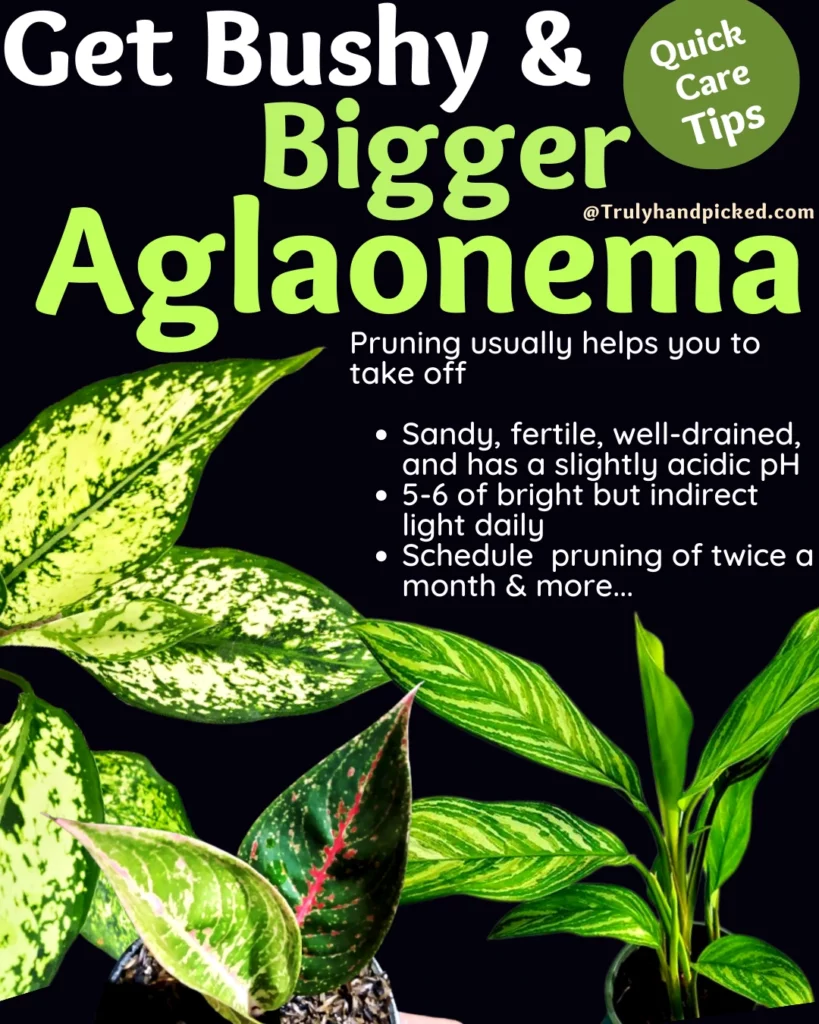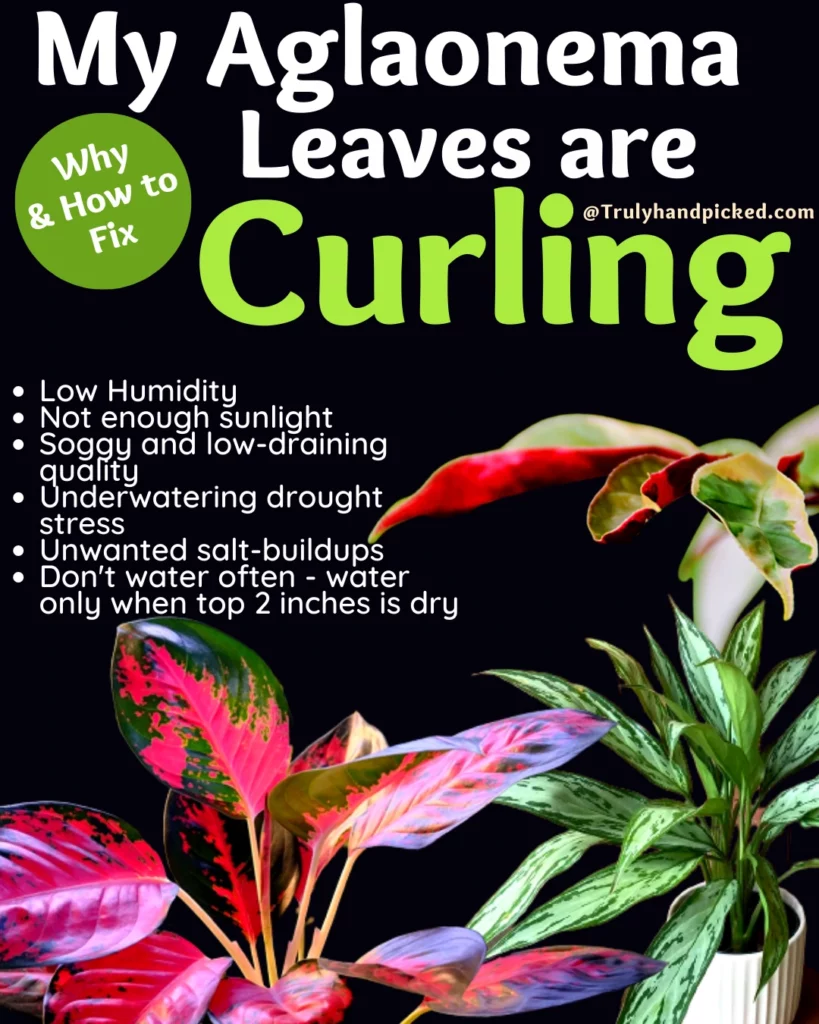Aglaonema is a vibrant ornamental houseplant that cultivates for its super gorgeous foliage. It is an easy-to-care plant with the least caring requirements along with an unusual variegated peek.
Aglaonema Curling Leaves Reasons: Mostly it’s sunlight and humidity stress if it receives more than what it needs it may curl and less watering can also make your plant wilt. Simply too much sunlight, under watering, low humidity, and pests or fungal attack cold. Lack of nutrients, root rot, and overwatering could result in yellowing leaves.
Get bushy aglaonema with bigger leaves: Pruning will help you get rid of old and dead leaves (damaged, brown, and yellow), with scheduled feed (spring and summer – skip in winter) and proper watering of your aglaonema will get bushy with bigger leaves.
This genus from the arum family comes in different sizes, depending on their selected species. You can grow Chinese evergreen plants uninterruptedly with normal care. But a little effort can reward you more surprisingly in this attempt.
As if, there are a few simple tricks that can stimulate your plant to grow with a more thriving and larger form. Here we come up with the best followable tips about the same-
Why Is My Aglaonema Plant Leaves Curling?
If you pick a Chinese evergreen plant as a houseplant, it’s probably for its extremely attractive leaves. So, no gardener allows to let that main attraction gets intervallic ever.
However, sometimes we find that the edges of your leaves start turning curled or wilted. That may appear for many reasons but you have to control and get rid of it in every possible way before it turns fatal for your plant.
Here are some most probable causes of this problem along with their best suitable solution ideas-
Too Much Watering:
- When you keep the soil consistently moist as aglaonema plant prefers dry soil to thrive
- If you water your plant more than once a week or in more depth than 1-inch
Fix:
- Don’t water your plant on a regular schedule ever and try watering less frequently
- Check the soil before watering and let at least the top 2-inches of the soil dry between watering
Related: Why my fern leaves are curling -how to fix
Drought Stress:
- Less watering doesn’t mean any watering at all
- It happens if your plant suffers from drought stress due to extremely low watering
How to Fix:
- Aim to water your plant only when the top 1-2 inches of soil turn dry
- Set the watering schedule depending on the hotness of the weather
Unsuitable Climate:
- If you place the pot in a room with a consistently cool climate or fluctuating temperatures
- When you grow an aglaonema plant in a room where the humidity level is extremely low
Solutions:
- Provide your plant with a steady warm growing temperature between 70° to 80° F
- Keep the humidity level always high in the room where you put your planter
Related: curling and yellowing leaves of Syngonium plant
Insufficient Light:
- It indicates that you must put the planter under too much bright or direct light for long
- Or you may let your plant sunburn for an uncertainly extended period
Solutions:
- You may put the planter in a spot where the light is indirect but moderately bright
- Let your plant get soaked under bright but indirect light through the sun with partial shade
Related: My aglaonema plant leaves are turning yellow – how to fix
Poor Water and Soil Quality:
- It means you must use normal tap water to hydrate your plant instead of distilled water
- Or you may pick poor soil with low-draining quality to sow your aglaonema plant
Solutions:
- Always use distilled water instead of tap or any unpurified water to hydrate an aglaonema plant
- Choose rich, fertile, and well-drained soil to plant this Chinese evergreen for a better growing experience
Nutrient Deficiency:
- It indicates that you must keep your plant unfertilized for more than one year
- Or the soil can’t absorb an adequate amount of the nutrients from the fertilizer due to improper pH level
Solutions:
- Due to being a foliage plant, the aglaonema plant needs moderate but consistent fertilization
- Also, you need to pick soil with a slightly acidic pH level. It can aid your plant in absorbing the essential nutrients from the soil more rapidly
Overfertilization:
- Overfertilization is as much bad as under-fertilization as it causes unwanted salt-buildups
- It means you are feeding your plant more than 4 times a year with an improper NPK ratio
Solutions:
- Feed your plant once or twice a year and only during the growing seasons
- Don’t forget to dilute your fertilizer with half of the strength every time before applying
Related: How to fix curling leaves on birds of paradise
Pest or Disease Infestation:
- Pests infestation and diseases contamination are the worst of all of them as they suck the essential nutrients from the plant and let it suffer with curling leaves issue
- So, it may indicate that you must let the infestation or the contamination happen to your plant for long
Solutions:
- Look for the common insects or possible diseases on your plant every few weeks
- And apply suitable remedies like insecticide spray, and anti-fungal solutions to your plant frequently until you get rid of them entirely.

How To Make Aglaonema Bushier?
To grow your indoor or outdoor aglaonema bushier, you can try a few selected moves, like watering perfectly, providing an accurate amount of light, feeding with a high-nitrogen fertilizer, etc.
But what affects the most in this attempt is a proper and successful pruning session. So, let’s check how to do the job like a pro to get bushier out of a growing aglaonema plant naturally-
How to Prune Perfectly:
- Pruning usually helps you to take off the old and yellow leaves out of your plant
- However, it has some other beneficial effects on your growing plant too
- So, to start the pruning session, let your plant reach the normal nature height which must be 12-18 inches or around it
- Now, wait till the first round of foliage turns old and then shed them with a clear pruner
- Make sure your trimming device is completely clean and sterilized before using
- You can cut some of the new shots as well during this session to get more amounts of shots at once
- Tip the newly trimmed stems and shots to encourage the plant to produce more shots from single stems
- This way you will get a dense or bushier form of an aglaonema plant within a shorter period
Related: How to make your hibiscus bushy and bloom better
How To Make Aglaonema Grow Faster with Bigger Leaves?
Aglaonema plants have a moderate growth rate with low-to-medium height. That can grow up to 20 inches tall a 24-inches wide. You can get this size within 2-3 years of the plantation.
The foliage of this plant can get nine to twelve inches long with four inches in width while fully matured. The alluring silver marking on the leaves makes them more amazing to glance at.
Now, these beautiful leaves can emphasize more magnificently when growing with a bigger and wider shape in the shortest period. So, let learn what are the most useful tricks here we can try in this challenge-
Pick The Right Soil:
- Pick a soil type that is sandy, fertile, well-drained, and has a slightly acidic pH
- Make sure the soil is amended well with potting mix, perlite, compost, and vermiculate
Provide Enough Light:
- Place your planter in a spot where it can stay away from direct sunlight
- Make sure your plant can grab five to six hours of bright but indirect light daily
Feed Twice a Year:
- Feed your plant with a balanced fertilizer twice a year with diluted half of the strong form
- Use a fertilizer that is high in nitrogen content comparably phosphorus and nitrogen
Related: How to make your philodendron grow faster with bigger leaves
Prune Regularly:
- Prune your plant following a regular schedule of twice a month
- Always keep the plant in a well-shaped form by keeping the old and unwanted parts trimmed
Maintain Proper Climate:
- Offer your plant a steady growing climate throughout its entire growing session
- Keep the growing temperature between 70° to 80° F and the humidity level always higher than 60%
Keep Protected:
- Check your plant every few days for any kind of pest or insect infestation
- Give your plant a good rinse with homemade insecticide or anti-fungal spray once in a while just to be on the safe side
So, follow these tips and be the owner of a healthy, thriving bigger aglaonema plant in the fasted way you can.
FAQ: Is Aglaonema Indoor Plant?
Aglaonema is an ornamental houseplant that can grow anywhere in your house with its adequate care and maintenance including in plain indoor gardens.
Can You Propagate Aglaonema in Water?
You can propagate a finely trimmed aglaonema plant in water as easily as in the soil medium. Try to use a bit bigger shoot to propagate them in water instead of potting mix.
